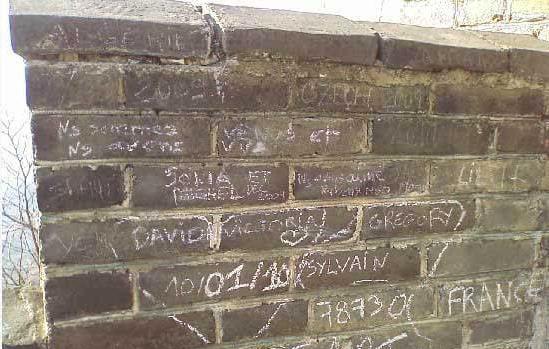A Scar on a Timeless Wonder: The Urgent Fight to Protect the Great Wall
Imagine standing before a colossal stone dragon, snaking across mountains, a testament to human ingenuity and perseverance. That’s the Great Wall of China, a UNESCO World Heritage site and one of the most iconic landmarks on Earth. But recently, this majestic symbol has faced a disheartening reality: vandalism. The shocking incident in Shanxi province, where an excavator was used to carve a shortcut through a section of the wall, served as a stark reminder of the ongoing threat to this invaluable cultural treasure. The damage, both physical and symbolic, resonated globally, prompting a renewed focus on preservation efforts. But how is China responding to this challenge, and what measures are being taken to safeguard this wonder for future generations?

(Source: https://www.nbcnews.com/business/travel/china-creating-designated-graffiti-zones-great-wall-n50046)
Fortress Under Threat: Increased Security Measures
The immediate response to the Shanxi incident involved bolstering security along vulnerable sections of the Great Wall. It’s a multi-layered approach, recognizing that a single solution won’t suffice.

(Source: http://chinaplus.cri.cn/news/china/9/20170818/18609.html)
- Enhanced Patrolling: Local police and security personnel are now conducting more frequent and intensive patrols, particularly in areas known for illegal activity or prone to damage. Think of it as a constant watch, ensuring that those who seek to exploit the wall’s remoteness are deterred.
- Surveillance Technology: The integration of modern technology is crucial. Cameras and sensors are being deployed to monitor activity in real-time, providing a digital eye on the wall’s vast expanse. This allows authorities to quickly identify and respond to potential threats.
- Restricting Access: While tourism is vital, certain sections of the wall are simply too fragile to be freely accessible. The previously off-limits Jiankou section, known for its dramatic scenery and precarious condition, is now being opened to tourism under strict controls, limiting visitor numbers and ensuring responsible exploration. Have you ever felt the thrill of discovering a hidden gem, knowing its fragility demands respect? That’s the spirit guiding these access restrictions.
Justice and Accountability: Legal Repercussions for Vandals

(Source: http://en.people.cn/n3/2017/0818/c90000-9257316.html)
The Chinese government is sending a clear message: damaging the Great Wall will not be tolerated.
- Swift Detention and Prosecution: The swift apprehension of the workers who used the excavator in Shanxi province demonstrates a commitment to holding perpetrators accountable. This wasn’t just a slap on the wrist; it was a signal that such actions have serious consequences.
- Stricter Laws on the Horizon: Discussions are underway to revise existing laws, increasing the severity of penalties for vandalism of cultural relics. This is a crucial step in deterring future offenses.
- Holding Organizations Accountable: The responsibility doesn’t stop with individuals. Construction companies and other organizations whose actions contribute to damage are also facing scrutiny and potential legal action. It’s about ensuring that everyone involved in the wall’s environment understands the importance of preservation.

(Source: https://www.scmp.com/news/china/society/article/2107020/anger-over-graffiti-great-wall-china)
A Community’s Responsibility: Engaging Locals and Raising Awareness
Preservation isn’t just about security and laws; it’s about fostering a sense of ownership and responsibility within the communities that live alongside the Great Wall.

(Source: https://www.nbcnews.com/business/travel/china-creating-designated-graffiti-zones-great-wall-n50046)
- Public Awareness Campaigns: Educational programs and public awareness campaigns are being launched to highlight the cultural and historical significance of the wall. Imagine a community where every child understands the importance of protecting their heritage – that’s the goal.
- Community Involvement: Local residents are being actively involved in monitoring and reporting suspicious activity. They are the eyes and ears of the preservation effort, possessing invaluable knowledge of the terrain and potential threats.
- Sustainable Tourism Initiatives: Promoting responsible tourism practices that benefit local communities while minimizing environmental impact is key. This ensures that tourism contributes to preservation, rather than contributing to its degradation.
Looking Ahead: A Shared Responsibility

The fight to protect the Great Wall is an ongoing one, requiring a collaborative effort from the government, local communities, and visitors alike. It’s a reminder that even the most enduring symbols of human achievement are vulnerable and require constant vigilance. As you plan your own visit to this magnificent wonder, remember that respecting its fragility is part of the experience. Let’s all play our part in ensuring that the Great Wall continues to inspire awe and wonder for generations to come. What steps will you take to help protect this incredible legacy?
[Image of the Great Wall with a caption about preservation efforts]








/https://tf-cmsv2-smithsonianmag-media.s3.amazonaws.com/filer/80/fa/80facab4-fe0e-4a56-bd99-a71eb1845fa0/01_14_2014_great_wall.jpg)